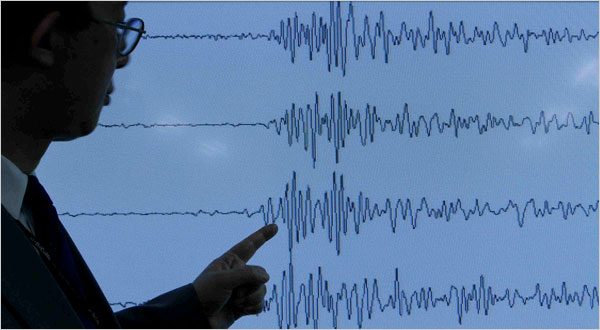The Costa Rica News (TCRN) – If it seems like earthquakes and erupting volcanoes are happening more frequently, that’s because they are. Looking at global magnitude six (M6) or greater from 1980 to 1989 there was an average of 108.5 earthquakes per year, from 2000 to 2009 the planet averaged 160.9 earthquakes per year: that is a 38.9% increase of M6+ earthquakes in recent years.

The conspiracy theorists have been sounding alarms for some time about this with fingers pointing to HAARP technology, geo-engineering, electromagnetic waves in the ionosphere, etc. Mainstream scientists simply say they are hand-picking data sets and that in reality our monitoring systems have become better as well as the fact that there is more media reporting so it only appears to be an increasing number of seismic events on the globe.
Statistics from the United States Geological Survey’s (USGS) Earthquake Hazards Program showing a significant increase M6 and greater events:
The cumulative number of earthquakes M3 or greater in the midcontinental United States. The number of M3 or greater earthquakes increases steadily at about 21 events per year until around 2000, when it increases about 50% to 31 events per year. By 2008, the number increased sharply to about 151 events per year.
Associated data set from the USGS, has prompted the USGS to launch a scientific study to determine if the increase is natural, or man-made. Click here to see the USGS article.
Unrest also seems to be growing among the world’s super-volcanoes. Iceland (which is home to some of the most dangerous volcanoes on the planet), Santorini in Greece, Uturuncu in Bolivia, the Yellowstone and Long Valley calderas in the U.S., Laguna del Maule in Chile, Italy’s Campi Flegrei – almost all of the world’s active super-volcanic systems are now exhibiting some signs of inflation, an early indication that pressure is building in these volcanic systems.
When they will erupt is guesswork, but in the meantime, activity is growing in Central America’s volcanoes such as Costa Rica’s Turrialba Volcano, Asia’s volcanoes such as Kamchatka, Alaska and Indonesia are also more active. Magma chambers are growing as pressures increase, the numbers of tremors are increasing as are related ‘quake-clusters’. If any one of these major volcanic systems has a large scale eruption, it would be a global event.

Iceland is considered by many scientists to be the next likely place for a global level volcanic event. The last major event, actually relatively minor, was in 2010 when an Icelandic volcano (Eyjafjallajökull volcano) made headlines around the world by spewing mega-tons of ash into the atmosphere, cancelling and re-routing thousands of flights and costing airlines and passengers more than $7 billion+ in lost revenues.
But Eyjafjallajökull is a baby compared to Bardarbunga, a volcano in central Iceland that has been dilating and venting. Dilation of the crater has been significant, and other signs of eminent eruption such quake clusters shaking the region are happening on a regular basis.
Costa Rica
According to the USGS, Costa Rica is very active seismically with earthquake and volcanoes. This is a result of the unique and diverse tectonic plate system that is made up of the Caribbean plate, and no fewer than four major adjacent plates (North America, South America, Nazca, and Cocos).
The massive Haiti earthquake of January 12, 2010, occurred on the boundary region separating the Caribbean plate and the North American plate.
Click here for a Poster of the Seismicity of the Caribbean Plate and Vicinity
For more information on this poster visit USGS http://earthquake.usgs.gov/earthquakes/eqarchives/poster/regions/caribbean.php
Apart from Costa Rica’s unique tectonic condition, this small country also sits on the infamous Ring of Fire. Eighty percent of all volcanic eruptions occur along the Ring of Fire. There are 452 volcanoes on the Ring of Fire holding over 75% of the world’s active and dormant volcanoes.
New research into the Sun and its Connection to Earthquake and Volcanic Activity here on Earth
The latest research connects the Sun to the Earth in fascinating new ways.
A 1967 study published in the Earth and Planetary Science journal, stated: “Solar activity, as indicated by sunspots, radio noise and geomagnetic indices, plays a significant but by no means exclusive role in the triggering of earthquakes.”
A 1998 report by a scientist from the Beijing Astronomical Observatory… “Earthquakes occur frequently around the minimum years of solar activity.”

As reported on NewScientist.com and numerous other science sites, including Space.com, the sun has recently entered into its lowest (minimum) activity levels in four centuries, coinciding with an increase in global seismic activity. “Solar activity is declining very fast at the moment,” Mike Lockwood, professor of space environmental physics at Reading University, UK, told New Scientist. “We estimate faster than at any time in the last 9300 years.”
Current Solar science looks at Sunspots, Solar Flares (charged particles), Solar Wind speed and density, Magnetic Field Shift, Shifting Ocean and Jet Stream Currents, Extreme Weather (including earthquakes, volcanoes, hurricanes or other extreme natural events), and have concluded that the Earth and the Sun are far more connected than previously thought.
Solar Science shows that these seismic events here on earth (as well as other planets and moons in our solar system) are connected directly to our sun’s activity, and may have more of an impact on climate change than previously thought. This extremely low solar active phase our star is in is projected to be with us for next 30 years along with the heightened climate and seismic activities associated with the phase.
The most recent study by the USGS finds there were more than twice as many big earthquakes in the first quarter of 2014 as compared with the average since 1979.
“We have recently experienced a period that has had one of the highest rates of great earthquakes ever recorded,” said lead study author Tom Parsons, a geophysicist with the U.S. Geological Survey (USGS) in California.
It seems that earthquakes and volcanic activity is on the rise and according to many scientific experts we can expect more in the near future.
The Costa Rica News (TCRN)
San José, Costa Rica
